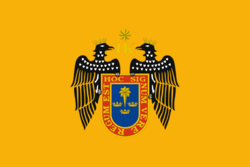Gold Museum of Peru and Weapons of the World
In the sixties of the 20th century, Miguel Mujica Gallo used his private collection made throughout his life to create a foundation that bears his name and which manages the collection named after him, the "Gold Museum of Peru and Weapons of the World", located in the district of Santiago de Surco, Lima, Peru.
The two-story building (12.1087S 76.9665W) that contains this collection is made of reinforced concrete and its entrance is through a vault-style large of a bank safe.
Donation to the State
The museum, donated to the Peruvian state by his creator, Miguel Mujica Gallo is administered by the Foundation Miguel Mujica Gallo. Currently, the Foundation is directed by Victoria Mujica Diez Canseco.
Gold of Peru
The acquisition of the Peruvian contents, of more than seven thousand pieces, was inspired by the admiration for the history of Peru had this prominent collector in order to leave a legacy to this country of goldsmiths from ancient times, as homage to the Peruvian pre-Columbian cultures in its various manifestations containing materials such as precious metals like gold, silver and some of platinum, multiple textiles, ceramics, mummies, and other valuable objects of the time.
Thus prevented these valuable jewels were exported and cultural heritage lost forever, ending up in the hands of unscrupulous reducers or be disbanded after his death.
His pieces give an idea, in general, what the Spanish found when they came to this country, resulting in the encounter between two cultures, one that gave the most value to precious metals and the local that valorised the time in performing work or make an object, despite having precious metals used for religious, power status, as tools or as part of their clothing or attire.
Those works exhibited in the museum have been found mostly in the Republican era and acquired at the time by Miguel Mujica Gallo.
Through them, it has been known not only advances in metallurgy, customs, beliefs and life was like in those cultures.
The gold and silver coated magical complex religious symbolism in all Peruvian cultures. In the pre-Incas, these metals represented a constant duality sun-moon, day-night, male-female. In the Inca Empire, the sun god or Inti represented sovereignty on the divine plane and the moon goddess or Mama Moon, also known as Mama Quilla was Inti's wife, mother of the sky. In the Temple of the Sun an order of priestesses worshiped.
The forms that these metals acquired indicated the seniority and power of those who used it in his life and the importance that they won in their burials.
The ancient Peruvians developed techniques unknown to Europeans, such as to color to metal surfaces golding or silvering.
All pre-Incan cultures were goldsmiths of these metals, but only four of them stood out at the highest level.
In this classification include the cultures Vicus, Moche, Sican and Chimu that it developed on the northern coast of Peru.
Subsequent to these cultures, emerges the Inca Empire that is richer in possession of metal objects in gold and silver and the quality and finesse of its finished.
Victoria Mujica, referring to historical documents found in the Archive of the Indies, cites one that says:
“ In the magnificent temple of Koricancha (Cusco) was a solid gold disc the size of a wagon wheel representing the sun god, golden idols-size human figure with gold and silver llamas also life-size and many of the same metal plates covering the walls of the temple".
Weapons of the World
Proceeds from his numerous travels abroad, Miguel Mujica Gallo was also collecting different weapons in the world, the oldest dating from the 13th century. C. He was a regular buyer in all major auctions where any.
Twenty thousand weapons of all times and countries are exhibited in the museum, than for quantity, quality, superb condition and the famous original holders of these parts can be considered one of the world's foremost in this specialty, product of the efforts of private collectors of the founder of this museum.
In its environments, as well as weapons, can be seen war uniforms, horse saddles, armor, spurs and other objects that define the early through time and characters of history for more than three thousand and three hundred years.
External links
-

Wikimedia Commons has media related to Museo Oro del Perú. - Official Website Museum Gold of Peru and Weapons of the World
Coordinates: 12°06′28″S 76°57′59″W / 12.10778°S 76.96639°W
